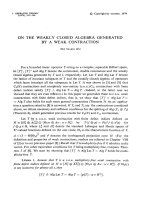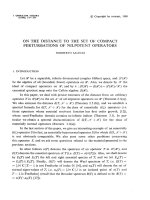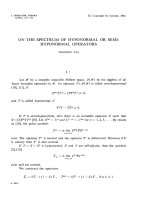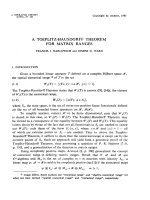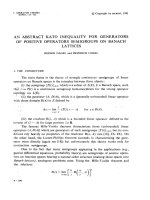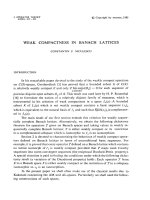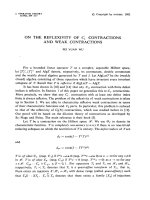Báo cáo toán học: " On the Koolen–Park inequality and Terwilliger graphs" pps
Bạn đang xem bản rút gọn của tài liệu. Xem và tải ngay bản đầy đủ của tài liệu tại đây (104.81 KB, 8 trang )
On the Koolen–Park inequality and Terwilliger graphs
Alexander L. Gavrilyuk
∗
Department of Algebra and Topology
Institute of Mathematics and Mechanics
Ural Division of the Russian Academy of Sciences, Russia
Submitted: Au g 11, 2010; Accepted: Au g 31, 2010; Published: Sep 13, 2010
Mathematics Subject Classifications: 05E30
Abstract
J.H. Koolen and J. Park proved a lower bound for the intersection number c
2
of a distance-regular graph Γ. Moreover, they showed th at a graph Γ, for which
equality is attained in this boun d, is a Terwilliger graph. We prove that Γ is the
icosahedron, the Doro graph or the Conway–Smith graph if equality is attained and
c
2
2.
1 Introduction
Let Γ be a distance-regular graph with degree k and diameter at least 2. Let c be maximal
such that, for each vertex x ∈ Γ and every pair of nonadjacent vertices y, z of Γ
1
(x), there
exists a c- coclique in Γ
1
(x) containing y, z. In [1], J.H. Koolen and J. Park showed that
the following bound holds:
c
2
− 1 max{
c
′
(a
1
+ 1) − k
c
′
2
| 2 c
′
c}, (1)
and equality implies that Γ is a Terwilliger graph. (For definitions see Sections 2 and 3.)
A similar inequality for a distance-regular graph with a c-claw was proved by C.D.
Godsil, see [2]. J.H. Koolen and J. Park [1] noted that the bound (1) is met for the three
known examples of Terwilliger graphs with c
2
2. We recall that only three examples
of distance-regular Terwilliger graphs with c
2
2 are known: the icosahedron, t he Doro
graph and the Conway–Smith graph.
In this paper, we will show that a distance-regular graph Γ with c
2
2, for which
equality is attained in (1), is a known Terwilliger graph.
∗
Partially suppo rted by the Russia n Foundation for Bas ic Research (project no . 08-01-00009).
the electronic journal of combinatorics 17 (2010), #R125 1
2 Definitio ns and preliminaries
We consider only finite undirected graphs without loops or multiple edges. Let Γ be a
connected gr aph. The distance d(u, w) between any two vertices u and w of Γ is the
length of a shortest path from u to w in Γ. The diameter diam(Γ) of Γ is the maximal
distance occurring in Γ.
For a subset A of the vertex set of Γ, we will also write A for the subgraph of Γ induced
by A. For a vertex u of Γ, define Γ
i
(u) to be the set of vertices that are at distance i from
u (0 i diam(Γ)). The subgraph Γ
1
(u) is called the local graph of a vertex u and the
degree of u is the number of neighbors of u, i.e., |Γ
1
(u)|.
For two vertices u, w ∈ Γ with d(u, w) = 2, the subgraph Γ
1
(u) ∩Γ
1
(w) is called the µ-
subgraph of vertices u, w. We say that the number µ(Γ) is well-defined if each µ-subgraph
occurring in Γ contains the same number of vertices and this number is equal to µ(Γ).
Let ∆ be a graph. A graph Γ is locally ∆ if, for all u ∈ Γ, the subgraph Γ
1
(u) is
isomorphic to ∆. A graph is regular with degree k if the degree of each of its vertices is
k.
A connected graph Γ with diameter d = diam(Γ) is distance-regular if there are integers
b
i
, c
i
(0 i d) such that, for any two vertices u, w ∈ Γ with d(u, w ) = i, there are
exactly c
i
neighbors of w in Γ
i−1
(u) and b
i
neighbors of w in Γ
i+1
(u) (we assume that
Γ
−1
(u) and Γ
d+1
(u) are empty sets). In particular, a distance-regular graph Γ is regular
with degree b
0
, c
1
= 1 and c
2
= µ(Γ). For each vertex u ∈ Γ and 0 i d, the subgraph
Γ
i
(u) is regular with degree a
i
= b
0
− b
i
− c
i
. The numbers a
i
, b
i
, c
i
(0 i d) are
called the intersection numbers and the array {b
0
, b
1
, . . . , b
d−1
; c
1
, c
2
, . . . , c
d
}, is called the
intersection array of the distance-regular graph Γ.
A graph Γ is amply regular with parameters (v, k, λ, µ) if Γ has v vertices, is regular
with degree k and satisfies the following two conditions:
i) for each pair of adjacent vertices u, w ∈ Γ, the subgraph Γ
1
(u) ∩ Γ
1
(w) contains
exactly λ vertices;
ii) µ = µ(Γ) is well-defined.
An amply regular graph with diameter 2 is called a strongly regular graph and is a
distance-regular graph. A distance-regular graph is an amply regular graph with param-
eters k = b
0
, λ = b
0
− b
1
− 1 and µ = c
2
.
A c-clique C of Γ is a complete subgraph (i.e., every two vertices of C are adjacent)
of Γ with exactly c vertices. We say that C is a clique if it is a c-clique for certain c. A
coclique C of Γ is an induced subgraph o f Γ with empty edge set. We say a coclique is a
c-coclique if it has exactly c vertices.
Let Γ be a strongly regular graph with parameters (v, k, λ, 1). There are integers r
and s such that the local graph of each vertex of Γ is the disjoint union of r copies of the
s-clique. Furthermore, v = 1 + rs + s
2
r(r − 1), k = rs and λ = s − 1. The set of strongly
regular graph with parameters ( 1 + rs + s
2
r(r − 1), rs, s − 1, 1) is denoted by F(s, r).
the electronic journal of combinatorics 17 (2010), #R125 2
Any graph of F(1, r), i.e., a strongly regular gra ph with λ = 0 and µ = 1, is called a
Moore strongly reg ular graph. It is well known (see Ch. 1 [3]) that any Moore strongly
regular graph has degree 2, 3, 7 or possibly 57. The graphs with degree 2, 3 and 7 are the
pentagon, the Petersen graph and the Hoffman–Singleton graph, respectively. It is still
unknown whether there exists a Moore graph with degree 57.
Lemma 2.1 If F(s, r) is a nonempty set of g raphs, then s + 1 r.
Proof. Let Γ be a graph of F(s, r). We can choose vertices u and w from Γ with d(u, w) = 2.
Let x be a vertex of Γ
1
(u) ∩ Γ
1
(w). Then the subgraph Γ
1
(w) − (Γ
1
(x) ∪ {x}) contains
a coclique of size at most r − 1. Let us consider an s-clique of Γ
1
(u) − Γ
1
(w) on vertices
y
1
, y
2
, , y
s
. The subgraph Γ
1
(w) ∩ Γ
1
(y
i
) (1 i s) contains a single vertex z
i
. The
vertices z
1
, z
2
, , z
s
are mutually nonadjacent and distinct. Hence, s r − 1. The lemma
is proved.
3 Terwilliger graphs
In this section we give a definition of Terwilliger graphs and some useful facts concerning
them.
A Terwilliger graph is a connected non-complete graph Γ such that µ(Γ) is well-defined
and each µ-subgraph occurring in Γ is a complete graph (hence, there are no induced
quadrangles in Γ). If µ(Γ) > 1, then, fo r each vertex u ∈ Γ, the local graph of u is also a
Terwilliger graph with diameter 2 and µ(Γ
1
(u)) = µ(Γ) − 1.
For an integer α 1, the α- clique extension of a graph
¯
Γ is the graph Γ obtained from
¯
Γ by replacing each vertex ¯u ∈
¯
Γ by a clique U with α vertices, where, fo r any ¯u, ¯w ∈
¯
Γ,
u ∈ U a nd w ∈ W , ¯u and ¯w are adjacent if and only if u and w are adjacent.
Lemma 3.1 Let Γ be an amply regular Terw i lliger graph with parameters (v, k, λ, µ),
where µ > 1. T hen there is a number α such that the local graph of each vertex of Γ is
the α- clique extension of a strongly regular Terwilliger graph with parameters (¯v,
¯
k,
¯
λ, ¯µ),
where
¯v = k/α,
¯
k = (λ − α + 1)/α, ¯µ = (µ − 1)/α,
and α
¯
λ + 1. In particular, if
¯
λ = 0, then α = 1.
Proof. The result follows from [3, Theorem 1.16.3].
There are only three amply regular Terwilliger graphs known with µ 2. All of
them are distance-regular and are characterized by theirs intersection arrays. The three
examples are:
(1) the icosahedron with intersection array {5, 2, 1; 1, 2, 5} is locally pentagon graph;
(2) the Doro graph with intersection array {10, 6, 4; 1, 2, 5} is locally Petersen graph;
(3) the Conway–Smith graph with intersection array {10, 6, 4, 1; 1, 2, 6, 10} is locally
Petersen graph.
the electronic journal of combinatorics 17 (2010), #R125 3
In [4], A. Gavrilyuk and A. Makhnev showed that a distance-regular locally Hoffman–
Singleton graph has intersection array {50, 42, 9; 1, 2, 42} or {50, 42, 1; 1, 2, 50} and hence
it is a Terwilliger graph. Whether there exist graphs with these intersection arrays is an
open question.
Lemma 3.2 Let Γ be a Terwill iger graph. Suppose that, for an integer α 1, the local
graph of each vertex of Γ is the α-clique extension of a Moore strongly regular graph ∆.
Then α = 1 and on e of the following hol ds:
(1) ∆ is the pentagon and Γ is the icosahedron;
(2) ∆ is the Peterse n graph and Γ is the Do ro graph or the Con way–Smith graph;
(3) ∆ is the Hoffman– Singl eton graph or a Moore graph with degree 57; in both cases,
the diameter of Γ i s at least 3.
Proof. It is easy to see that the graph Γ is amply regular. By Lemma 3.1, we have
α = 1. Statements (1) and (2) follow from [3, Proposition 1.1.4] and [3, Theorem 1.16.5],
respectively.
If the graph ∆ is the Hoffman–Singleton g r aph and the diameter of Γ is 2, then Γ
is strongly regular with parameters (v, k, λ, µ), where k = 50, λ = 7 and µ = 2. By
[3, Theorem 1.3.1], the eigenvalues of Γ are k and the roots of the quadratic equation
x
2
+ (µ −λ)x+ (µ −k) = 0. The roots of the equation x
2
− 5x −48 = 0 are not integers, a
contradiction. In the remaining case, when ∆ is regular with degree 57 , we get the same
contradiction. The lemma is proved.
The next lemma will be used in the proof of Theorem 4.2 (see Section 4).
Lemma 3.3 Let Γ be a strongly regular Terwilli ger graph with parameters (v, k, λ, µ).
Suppose that, for an integer α 1, the local graph of each v ertex of Γ is the α-clique
extension of a strongly regular graph with parameters (¯v,
¯
k,
¯
λ, ¯µ). Then the inequality
¯
k −
¯
λ − ¯µ > 1 implies that k − λ − µ > 1.
Proof. We have k = α(1+
¯
k+
¯
k(
¯
k−
¯
λ−1)/¯µ), λ = α
¯
k+α−1 and µ = α¯µ+1. If
¯
k−
¯
λ−¯µ > 1,
then
¯
k(
¯
k −
¯
λ − 1)/¯µ >
¯
k and this implies that k − λ − µ = α(
¯
k(
¯
k −
¯
λ − 1)/¯µ − ¯µ) >
α(
¯
k − ¯µ) > α(
¯
λ + 1) 1.
4 The Koolen–Park in equality
In this section, we consider bound (1) and classify distance-regular graphs with c
2
2,
for which this bound is atta ined.
The next statement is a slight generalization o f Proposition 3 from [1], which was
formulated by J.H. Koolen and J. Park f or distance-regular graphs. We generalize it to
amply regular gr aphs. (Our proof is similar to the proof in [1], but we give it for the
convenience of the reader.)
the electronic journal of combinatorics 17 (2010), #R125 4
Proposition 4.1 Let Γ be an amply regular graph with parameters (v, k, λ, µ), and let
c 2 be m axim al such that, for each vertex x ∈ Γ and eve ry pair of no nadj a cent vertices
y, z of Γ
1
(x), there exists a c-coclique in Γ
1
(x) containing y, z. Then
µ − 1 max{
c
′
(λ + 1) − k
c
′
2
| 2 c
′
c},
and, if equality is attained, then Γ is a Terwilliger graph.
Proof. Let Γ
1
(x) contain a coclique C
′
on vertices y
1
, y
2
, . . . , y
c
′
, c
′
2. Since d(y
i
, y
j
) = 2,
it follows that |Γ
1
(x) ∩ Γ
1
(y
i
) ∩ Γ
1
(y
j
)| µ− 1 holds for all i = j. Then, by the inclusion–
exclusion principle,
k = |Γ
1
(x)| | ∪
c
′
i=1
(Γ
1
(x) ∩ (Γ
1
(y
i
) ∪ {y
i
}))|
c
′
i=1
|Γ
1
(x) ∩ (Γ
1
(y
i
) ∪ {y
i
})| −
1i<jc
′
|Γ
1
(x) ∩ Γ
1
(y
i
) ∩ Γ
1
(y
j
)|
c
′
(λ + 1) −
c
′
2
(µ − 1).
So,
µ − 1
c
′
(λ + 1) − k
c
′
2
. (2)
Note that equality in (2) implies that the inclusion Γ
1
(x) ⊆ ∪
c
′
i=1
(Γ
1
(y
i
) ∪ {y
i
}) holds
and we have |Γ
1
(x) ∩ Γ
1
(y
i
) ∩ Γ
1
(y
j
)| = µ − 1 for all i = j.
Let c be the maximal number satisfying the condition of Proposition 4.1. Then
µ − 1 max{
c
′
(λ + 1) − k
c
′
2
| 2 c
′
c}. (3)
We may assume that for an integer c
′′
, where 2 c
′′
c, (3) turns into equality, i.e.,
µ − 1 =
c
′′
(λ + 1) − k
c
′′
2
= max{
c
′
(λ + 1) − k
c
′
2
| 2 c
′
c}. (4)
We will show that c = c
′′
. For a vertex x ∈ Γ and nonadjacent vertices y, z ∈ Γ
1
(x),
there exists a c-coclique C in Γ
1
(x) containing y, z. Equality (4) implies that, for any
subset of vertices {y
1
, y
2
, . . . , y
c
′′
} ⊆ C, we have Γ
1
(x) ⊆ ∪
c
′′
i=1
(Γ
1
(y
i
) ∪ {y
i
}). However, if
c
′′
< c, then C ⊂ ∪
c
′′
i=1
(Γ
1
(y
i
) ∪ {y
i
}), a contradiction.
Hence, c = c
′′
and we have |Γ
1
(x)∩Γ
1
(y)∩Γ
1
(z)| = µ−1 for every pair of nonadja cent
vertices y, z ∈ Γ
1
(x) and for all x ∈ Γ. This implies that each µ-subgraph in Γ is a clique
of size µ and Γ is a Terwilliger graph.
We call inequality (3) the µ-bound.
It is easy to check that the three known Terwillger graphs with µ 2 (see Section 3)
have equality in the µ-bound.
Our main theorem is to show that the only Terwilliger graphs with µ 2 a nd equality
in the µ-bound are the three known examples (of Section 3) .
the electronic journal of combinatorics 17 (2010), #R125 5
Theorem 4.2 Let Γ be an ampl y regular graph with parameters (v, k, λ, µ), and let µ > 1.
If the µ-bound is attained, then µ = 2 an d Γ i s the icosahedron, the Doro graph or the
Conway–Smith graph.
Proof. By Proposition 4.1, the graph Γ is a Terwilliger graph and, by Lemma 3.1, there is
an integer α 1 such t hat the local graph of ea ch vertex of Γ is the α-clique extension of
a strongly regular Terwilliger graph with parameters (¯v,
¯
k,
¯
λ, ¯µ). By Lemma 3.1, we have
k = α¯v, λ = α
¯
k + (α − 1) and µ = α¯µ + 1.
By the assumption on Γ, for a vertex u ∈ Γ, the local g r aph of u contains a c-co clique,
for which equality is a t t ained in the µ-bound, i.e.,
µ − 1 = α¯µ =
c(λ + 1) − k
c
2
=
c(α
¯
k + (α − 1) + 1) − α¯v
c
2
= α
c(
¯
k + 1) − ¯v
c
2
and
¯µ =
c(
¯
k + 1) − ¯v
c
2
.
Hence, c satisfies the following quadratic equation:
c
2
¯µ − c(¯µ + 2(
¯
k + 1)) + 2¯v = 0,
in other words,
c =
(¯µ + 2(
¯
k + 1)) ±
(¯µ + 2(
¯
k + 1))
2
− 8¯v ¯µ
2¯µ
.
This implies that
(¯µ + 2(
¯
k + 1))
2
8¯v¯µ.
Let the subgraph Γ
1
(u) be isomorphic to the α-clique extension of a strongly regular
Terwilliger graph with parameters (¯v,
¯
k,
¯
λ, ¯µ), say ∆. The cardinality of the vertex set of
∆ is ¯v = 1 +
¯
k +
¯
k(
¯
k −
¯
λ − 1)/¯µ, hence
(¯µ + 2(
¯
k + 1))
2
8(¯µ +
¯
k¯µ +
¯
k(
¯
k −
¯
λ − 1)),
¯µ
2
+ 4 4¯µ + 4
¯
k¯µ + 4
¯
k
2
− 8
¯
k
¯
λ − 16
¯
k.
Further,
(¯µ/2)
2
+ 1 ¯µ +
¯
k¯µ +
¯
k
2
− 2
¯
k
¯
λ − 4
¯
k,
((¯µ/2) − (
¯
k + 1))
2
2
¯
k(
¯
k −
¯
λ − 1). (5)
Let us first consider the case ¯µ = 1. There are integers s, r such that ∆ ∈ F(s, r) a nd
¯
k = rs,
¯
λ = s − 1. If
¯
k −
¯
λ − 1
¯
k/2 + 1, then 2
¯
k(
¯
k −
¯
λ − 1) 2
¯
k(
¯
k/2 + 1) =
¯
k
2
+ 2
¯
k.
It follows fr om (5) that (
¯
k + 1/2)
2
¯
k
2
+ 2
¯
k and hence 1/4
¯
k, which is impossible.
Therefore,
¯
k −
¯
λ − 1 <
¯
k/2 + 1, i.e.,
¯
k < 2(
¯
λ + 2). Substituting the expressions for
¯
k and
¯
λ into the previous inequality, we get rs < 2(s + 1). By Lemma 2.1, we have s + 1 r.
Hence, s + 1 r < 2(s + 1)/s and it follows that s = 1, r ∈ {2, 3} and ∆ is the pentagon
the electronic journal of combinatorics 17 (2010), #R125 6
or t he Petersen graph. As we already checked that the three examples in Lemma 3.2 (i)
and (ii) satisfy equality in the µ-bound, Theorem 4.2 follows in this case from Lemma
3.2.
Now we may assume ¯µ > 1. Since ¯µ <
¯
k, t he left-hand side of (5) is at most
¯
k
2
.
On the other hand, if
¯
k −
¯
λ − 1 >
¯
k/2, then the right-hand side of (5) is greater than
2
¯
k
¯
k/2 =
¯
k
2
, which is impossible. Hence, we have
¯
k −
¯
λ − 1
¯
k/2, i.e.,
¯
k 2(
¯
λ + 1).
Since ¯µ > 1, there is an integer α
1
1 such that, for a vertex w ∈ ∆, the subgraph
∆
1
(w) is the α
1
-clique extension of a strongly regular Terwilliger graph, say Σ, with
parameters (v
1
, k
1
, λ
1
, µ
1
), where v
1
=
¯
k
α
1
, k
1
=
¯
λ − (α
1
− 1)
α
1
, µ
1
=
¯µ − 1
α
1
. Then the
inequality
¯
k 2(
¯
λ + 1) is equivalent to the inequality v
1
2(k
1
+ 1) and the cardinality
of the vertex set of Σ is
v
1
= 1 + k
1
+ k
1
(k
1
− λ
1
− 1)
µ
1
.
Further, v
1
2(k
1
+ 1) implies that
k
1
(k
1
− λ
1
− 1)
µ
1
k
1
+ 1,
so
k
1
− λ
1
− 1 µ
1
(1 + 1/k
1
) < µ
1
+ 1
and
k
1
< λ
1
+ µ
1
+ 2. (6)
If µ
1
= 1, then, for certain s
1
, r
1
, we have k
1
= r
1
s
1
and λ
1
= s
1
− 1. It follows f rom
(6) that r
1
s
1
< s
1
− 1 + 1 + 2 = s
1
+ 2, r
1
< 1 + 2/s
1
and s
1
= 1, r
1
= 2. Hence, the graph
∆
1
(w) is the α
1
-clique extension of the pentagon. By Lemma 3.2, the graph ∆ is the
icosahedron and the diameter of Γ
1
(u) is 3, which is impossible because Γ is a Terwilliger
graph.
Hence, µ
1
> 1. Let us consider a sequence of strongly regular graphs Σ
1
= Σ,
Σ
2
, . . . , Σ
h
, h 2, such that, for an integer α
i+1
1, the local graph of a vertex in
Σ
i
is the α
i+1
-clique extension of a strongly regular Terwilliger graph Σ
i+1
with pa rame-
ters (v
i+1
, k
i+1
, λ
i+1
, µ
i+1
), 1 i < h and µ(Σ
h
) = 1, i.e., Σ
h
∈ F(s
h
, r
h
) for certain s
h
, r
h
.
Such a sequence exists by Lemma 3.1.
Assuming s
h
> 1, we get k
h
−λ
h
−µ
h
= r
h
s
h
−(s
h
−1)−1 = s
h
(r
h
−1) > 1. According
to Lemma 3.3, we have k
i
− λ
i
− µ
i
> 1 for all 1 i h − 1, which contradicts (6).
Hence, s
h
= 1 and Σ
h
is a Moore strongly regular graph. By Lemma 3.2, the diameter of
Σ
h−1
is at least 3, and this contradiction completes the proof.
Acknowledgement s
I would like to thank Ekaterina Vasilyeva and Maxim Ananyev (for the help in trans-
lation of this paper to English) and Prof . Jack Koo len for his comments, which greatly
improved the paper. I would also like to thank J. Park for his careful rea ding of the paper.
This work was partially supported by the Russian Foundation for Basic R esearch
(project no. 08-01-00009).
the electronic journal of combinatorics 17 (2010), #R125 7
References
[1] J.H. Koolen, J. Park: Shilla distance-regular graphs. // arXiv:0902.38 60 [math.CO]
[2] C.D. Godsil: G eometric distance-regular covers // New Zealand J. Math. 22 (19 93),
3138.
[3] A.E. Brouwer, A.M. Cohen, A. Neumaier: Distance-Regular Gra phs. Springer-
Verlag, Berlin Heidelberg New York, 1989.
[4] A.L. Gavrilyuk, A.A. Makhnev: Locally Hoff man–Singleton Distance-Regular
Graphs // to appear.
the electronic journal of combinatorics 17 (2010), #R125 8
